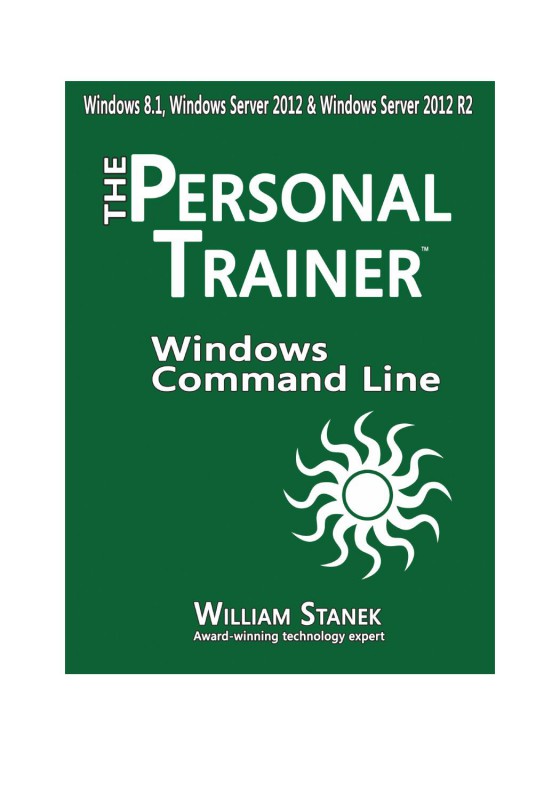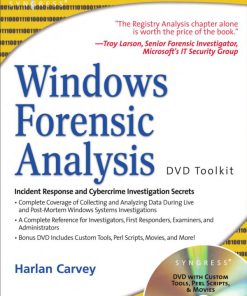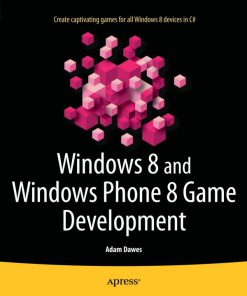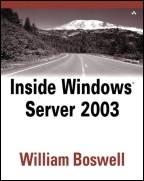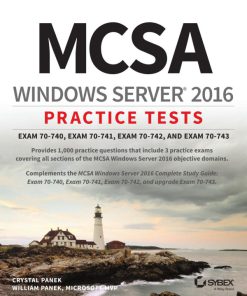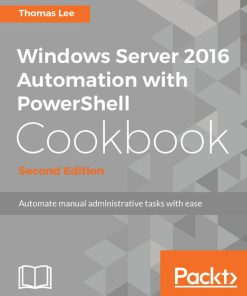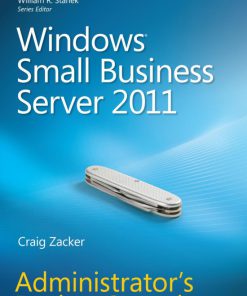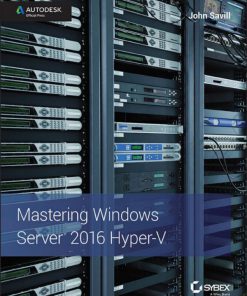Windows Command Line for Windows 8 1 Windows Server 2012 Windows Server 2012 R2 1st Edition by William Stanek ISBN B00S7AWSIC
$50.00 Original price was: $50.00.$25.00Current price is: $25.00.
Authors:William R. Stanek , Series:IT & Computer [326] , Tags:Computers; Operating Systems; Windows Desktop , Author sort:Stanek, William R. , Ids:Google; 9780735620384 , Languages:Languages:eng , Published:Published:Mar 2004 , Publisher:Microsoft Press , Comments:Comments:Portable and precise, this pocket-sized guide delivers ready answers for managing Microsoft Windows Server 2003 and Windows XP from the command line. Zero in on core command-line tools and techniques—learning timesaving ways to extend your operational efficiency and reach over multiple domains and networks. With its quick-reference tables, lists, and step-by-step instructions, this book delivers the fast, accurate information you need to get the job done—whether you’re at your desk or in the field!Get fast facts to: Create and use command-line scripts Perform multiple, complex operations by grouping commands Run commands, scripts, and programs on a scheduled basis Use event-logging tools to monitor and fine-tune system performance Gain control over disks beyond what you can do from the GUI Administer Active Directory users and groups, computer accounts, and domains Maintain network printers and print services Configure, manage, and troubleshoot TCP/IP networking services Get tips for using command-line related Resource Kit tools
Windows Command Line for Windows 8.1 Windows Server 2012 Windows Server 2012 R2 1st Edition by William Stanek – Ebook PDF Instant Download/Delivery. B00S7AWSIC
Full download Windows Command Line for Windows 8.1 Windows Server 2012 Windows Server 2012 R2 1st Edition after payment
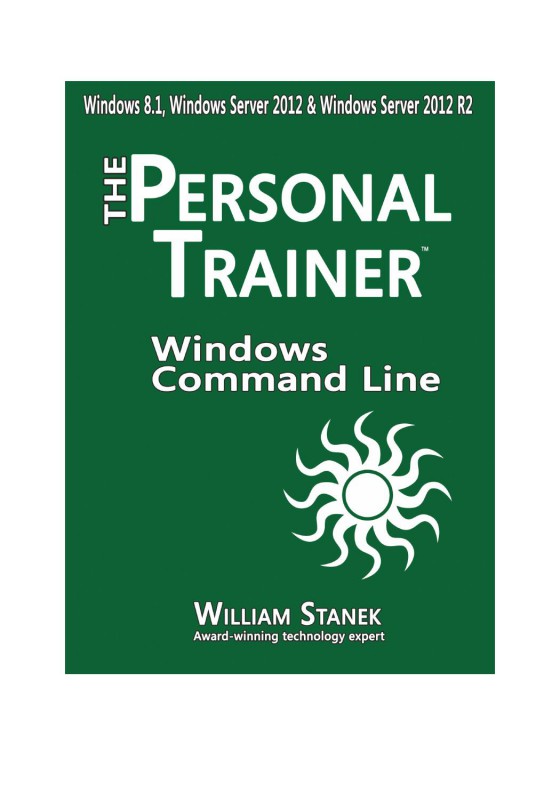
Product details:
ISBN 10: B00S7AWSIC
ISBN 13:
Author: William Stanek
Chances are that if you work with Windows computers you’ve used Windows Command Line. You may even have run commands at the command prompt. However, you probably still have many questions about Windows Command Line and may also wonder what tools and resources are available.
This practical hands-on guide for Windows power users and IT professionals delivers ready answers for using Windows command-line tools to manage Windows 8.1, Windows Server 2012, and Windows Server 2012 R2. Not only is this book packed with examples that show you how to run, use, schedule, and script Windows commands and support tools, it’s written by a well-known author of more than 100 computer books and features easy-to-read tables, lists, and step-by step instructions.
Designed for anyone who wants to learn Windows Command Line, this book will help you perform tasks more efficiently, troubleshoot performance issues and programs, manage computer settings, perform routine maintenance, and much more. One of the goals is to keep the content so concise that the book remains compact and easy to navigate while at the same time ensuring that the book is packed with as much information as possible–making it a valuable resource.
Windows Command Line for Windows 8.1 Windows Server 2012 Windows Server 2012 R2 1st Table of contents:
Chapter 1: Introduction to the Windows Command Line Interface
1.1 What is the Command Line Interface (CLI)?
1.2 Differences Between Command Line and GUI
1.3 Overview of the Windows Command Prompt
1.4 The Role of PowerShell vs. Command Prompt
1.5 How to Access the Command Line in Windows 8.1, Windows Server 2012, and Windows Server 2012 R2
1.6 Basic CLI Navigation and Commands
Chapter 2: Getting Started with Command Line Commands
2.1 Understanding Command Syntax
2.2 Basic File and Directory Commands
2.3 Navigating the File System Using Command Line
2.4 Managing Files and Directories
2.5 Using Wildcards and Regular Expressions in Commands
2.6 Redirecting Output and Piping Commands
Chapter 3: Working with System Information and Configuration
3.1 Viewing System Information via the Command Line
3.2 Checking and Managing System Resources (CPU, Memory, Disk)
3.3 Managing Time and Date Settings from the Command Line
3.4 Configuring Network Settings
3.5 Working with Users and Groups from the CLI
3.6 Viewing and Modifying Environment Variables
Chapter 4: File Management and Manipulation
4.1 Creating, Copying, and Moving Files
4.2 Deleting Files and Directories
4.3 Using xcopy and robocopy for Advanced File Copying
4.4 File Compression and Archiving from the Command Line
4.5 Managing File Permissions via CLI
4.6 Finding Files and Folders Using Command Line
Chapter 5: Networking and Remote Administration
5.1 Basic Networking Commands (ping, tracert, ipconfig, etc.)
5.2 Configuring TCP/IP and DNS Settings from the Command Line
5.3 Managing Network Shares and Permissions
5.4 Using netstat for Network Monitoring
5.5 Using Telnet and SSH for Remote Connections
5.6 Managing Remote Systems with PsExec
Chapter 6: User and Group Management
6.1 Managing User Accounts with net user
6.2 Creating and Modifying Groups with net localgroup
6.3 Configuring User Permissions and Access
6.4 Managing Password Policies via Command Line
6.5 Working with Active Directory Users and Groups
6.6 Resetting User Passwords from the Command Line
Chapter 7: System and Disk Management
7.1 Using Diskpart for Disk Management
7.2 Formatting and Partitioning Drives via Command Line
7.3 Checking and Repairing Disk Errors with chkdsk
7.4 Managing Disk Space with dir, tree, and other commands
7.5 Using sfc for System File Check
7.6 Backing Up and Restoring the System via Command Line
Chapter 8: Automating Tasks with Batch Files
8.1 Introduction to Batch Scripting
8.2 Creating and Running Simple Batch Files
8.3 Automating Routine Maintenance with Batch Files
8.4 Conditional Statements in Batch Scripting
8.5 Using Loops and Functions in Batch Files
8.6 Troubleshooting Batch Scripts
Chapter 9: Security and User Access Control
9.1 Managing Windows Firewall via Command Line
9.2 Configuring User Access Control (UAC)
9.3 Running Commands as Administrator with Elevated Permissions
9.4 Managing Security Policies via netsh
9.5 Encrypting Files and Folders Using Cipher
9.6 Setting Up Scheduled Tasks with Task Scheduler
Chapter 10: PowerShell Commands for Windows 8.1 and Windows Server 2012
10.1 Introduction to PowerShell vs. Command Prompt
10.2 Running PowerShell Scripts and Cmdlets
10.3 PowerShell Commands for System Configuration
10.4 File and Directory Management with PowerShell
10.5 PowerShell for Network Configuration
10.6 Automating Tasks with PowerShell Scripting
Chapter 11: Managing and Configuring Windows Services
11.1 Viewing and Managing Services with net start/net stop
11.2 Configuring Services with sc command
11.3 Using PowerShell to Manage Windows Services
11.4 Managing Service Dependencies and Recovery Options
11.5 Troubleshooting Service Issues from the Command Line
11.6 Configuring Windows Event Log for Service Monitoring
Chapter 12: Advanced Command Line Techniques
12.1 Creating and Managing Scheduled Tasks via Command Line
12.2 Working with the Windows Registry through Command Line
12.3 Event Log Management and Log Filtering
12.4 Using Windows Management Instrumentation (WMI)
12.5 Accessing and Managing Local and Remote Systems
12.6 PowerShell Remoting for Advanced Administration
Chapter 13: Troubleshooting and Diagnostics
13.1 Using System Tools for Diagnostics (msconfig, eventvwr)
13.2 Troubleshooting Boot Issues with bootrec and bcdedit
13.3 Analyzing and Fixing System Errors from the Command Line
13.4 Network Diagnostics and Troubleshooting with tracert, ping, nslookup
13.5 Using System Information and Diagnostic Tools
13.6 Monitoring Processes and Performance via Tasklist and taskkill
Chapter 14: Windows Server Specific Commands
14.1 Managing Windows Server Roles and Features
14.2 Installing and Configuring IIS via Command Line
14.3 Configuring Active Directory Services from the CLI
14.4 Using Server Manager via Command Line
14.5 Managing Hyper-V Virtualization from Command Line
14.6 Automating Server Tasks with PowerShell on Windows Server
People also search for Windows Command Line for Windows 8.1 Windows Server 2012 Windows Server 2012 R2 1st:
windows command-line for windows
windows command line for beginners
windows command line windows update
windows command line commands
windows command line linux
You may also like…
eBook PDF
Windows Server 2016 Automation With PowerShell Cookbook 1st Edition by Thomas Lee ISBN 9781787122048
eBook PDF
Mastering Windows Server 2016 Hyper V 1st Edition by John Savill ISBN 1119286204 9781119286202

